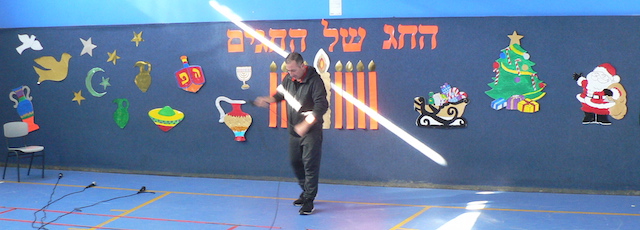Nazareth Illit in the Galilee, Northern Israel, is not even remotely a fancy town full of Biblical sights and experiences. To such an extent that a couple of years ago the authorities decided to rename it Nof HaGalil, “A view of the Galilee”, a pathetic effort to upgrade the place. Below this collection of concrete buildings that have seen better days, lies the Biblical city of Nazareth, well known in Christian culture as the place where Jesus grew up, and still a popular destination for pilgrims and tourists.
The city on the hill is a mixture of very different ethnic groups, most of them situated in the lower strata of Israeli society. Russian immigrants, not entirely successfully integrated, Arab communities, both Christian and Moslem, struggling to make ends meet, poor people surrounded by stained concrete. Neighbourhoods living in poverty, their income largely based on government support of various kinds. Inefficient local government that struggles to clear the garbage from the streets does not create an attractive first impression.
I arrive in order to visit Mishol, an urban inner city kibbutz. Inspired by the traditional village kibbutz community, urban kibbutzim are meeting the needs of 21st century cities. Instead of settling the country and defining its borders, these urban collectives do social work and teaching within the poorest cities and towns all over Israel.
Due to the chaotic nature of life in Israel, next morning I find myself in a local neighbourhood school, celebrating “The festival of festivals”. Hundreds of people in the school sports hall, crackling microphones and loudspeakers. Crowded, buzzing with excitement, the kids are dressed up in all kinds of costumes, class by class. The youngest are in the first grade, six year olds and full of themselves.
On the back wall there are decorations. I see a big Father Christmas, in his red and white costume, lacking reindeer, but with a sled - at least that. Totally incongruous here in the Galilee. It’s also the Jewish festival of Hanukkah, the festival of light, when traditionally an 8 armed candlestick is lit every day for 8 days. There is a picture of that on the back wall too and other symbols of the festival. There is also a green crescent and other symbols from the Moslem tradition.
The festival opens, much crackling from the microphone, with a group of children explaining that this is a festival for all three religions, Christmas and Hannukah, and even though the Moslems don’t have a specific festival just now, we are also celebrating their religion. Not their religion, our religions. The children here in this school come from all three faiths and many ethnic backgrounds. The grand entrance of the first group of dancers would have fitted well into Red Square in Moscow, with music that could have come straight from the Red Army Choir.
For the next hour we have Jingle Bells sung like I never heard it before, traditional Jewish Hanukkah songs and several Arabic tunes played over the loudspeakers with dancing, culminating in a belly dancing show
This school is very special, maybe half the teachers come from Mishol, the principal too. Many of the children are from the kibbutz as well. It’s a 10 minute walk away, and the school very much reflects the ethos of the kibbutz. Cooperation between ethnic and religious groups, social justice, and a decent life for all regardless of their background. Mishol is big, 150 people living collectively under one roof, half of them children. No one gets a salary, there are no private cars, and there are lots of shared facilities. A music room, a training room, camping store, meeting rooms and guest rooms.
One of the more recent projects the school has initiated is a big greenhouse in the school yard, completed just a few months before. That was the reason I was invited, to give a permaculture presentation about designing urban gardening and growing, and to explore how to use permaculture design thinking when integrating different ethnic groups. At the talk I met several people from Bustan, a multi-ethnic group that has been developing for the last year and a half.
In permaculture we have a principle of starting in the worst area when developing a site, designing paradise out of accumulated waste and destruction. A phoenix arising from the ashes. Is this a glimpse of a possible future? Can we really overcome our cultural, religious and ethnic differences and create a society where we live next to each other in friendship and respect? Is this the meaning of ideological intentional community that has an aim of creating a better society?
I was there only for a short visit, less than 24 hours, but I realised what a difference an intentional community can make when its members are committed to social renewal and really work at it. I shouldn’t really be surprised, that’s what intentional community can do, what it has often done, and what it will carry on doing.
